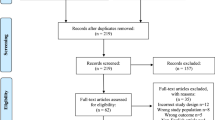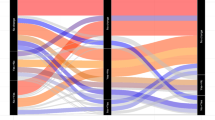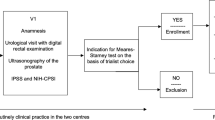Abstract
We investigated the effect of prostatic inflammation on prostate-specific antigen (PSA) and per cent-free PSA levels changing after antibacterial therapy. We evaluated 48 patients whose PSA levels were between 4 and 10 ng/ml, without any suspicious findings on digital rectal examination, with no infection findings in urine analysis. Prostatic inflammation was assessed with prostatic massage. All the patients were given antibiotic therapy for 3 weeks. Patients were re-evaluated 3 weeks after antibacterial therapy with PSA (free/total) and urinalysis. Ten core biopsies were taken with transrectal ultrasound. No differences were found in terms of age, pre- and post-treatment PSA, and PSA varying between patients with and without inflammation in the prostatic massage. In 18 patients, PSA decreased below 4 ng/ml. Prostate cancer was found in 10.8% of the patients with PSA between 4 and 10 ng/ml and none of the patients with PSA values below 4 ng/ml. We suggest an antibiotic therapy for 3 weeks without regarding inflammation findings when PSA is in the gray zone, for biopsy decision.
This is a preview of subscription content, access via your institution
Access options
Subscribe to this journal
Receive 4 print issues and online access
$259.00 per year
only $64.75 per issue
Buy this article
- Purchase on Springer Link
- Instant access to full article PDF
Prices may be subject to local taxes which are calculated during checkout

Similar content being viewed by others
References
Keetch DW, Catalona WJ, Smith DS . Serial prostatic biopsies in men with persistently elevated serum PSA values. J Urol 1994; 151: 1571–1574.
Eskiçorapçı SY, Baydar DE, Akbal C, Sofikerim M, Gunay M, Ekici S et al. An extended 10-core transrectal ultrasonography guided prostate biopsy protocol improves the detection of prostate cancer. Eur Urol 2004; 45: 444–449.
Schmid H-P, Prikler L, Sturgeon CM, Semjonow A . Diagnosis of prostate cancer – the clinical use of prostate specific antigen. EAU Update Ser 2003; 1: 3–8.
Neal Jr DE, Clejan S, Sarma D, Moon TD . Prostate specific antigen and prostatitis. I. Effect of prostatitis on serum PSA in the human and nonhuman primate. Prostate 1992; 20: 105–111.
Nadler RB, Humphrey PA, Smith DS, Catalona WJ, Ratliff TL . Effect of inflammation and benign prostatic hyperplasia on elevated serum prostate specific antigen levels. J Urol 1995; 154: 407–413.
Morote J, Lopez M, Encabo G, Torres IM . Effect of inflammation and benign prostatic enlargement on total and percent free serum prostatic specific antigen. Eur Urol 2000; 37: 537–540.
Irani J, Levillain P, Goujon JM, Bon D, Dore B, Aubert J . Inflammation in benign prostatic hyperplasia: correlation with prostate specific antigen value. J Urol 1997; 157: 1301–1304.
Bozeman CB, Carver BS, Eastham JA, Venable DD . Treatment of chronic prostatitis lowers serum prostate specific antigen. J Urol 2002; 167: 1723–1726.
Karazanashvilii G, Managadze L . Prostate-specific antigen value change after antibacterial therapy of prostate inflammation, as a diagnostic method for prostate cancer screening in cases of PSA value within 4–10 ng/ml and nonsuspicious results of digital rectal examination. Eur Urol 2001; 39: 538–543.
Carver BS, Caleb BB, Williams BJ, Venable DD . The prevalence of men with national institutes of health category IV prostatis and association with serum prostate specific antigen. J Urol 2003; 169: 589–591.
Reiter RE, deKernion JB . Epidemilogy, etiology, and prevention of prostate cancer. In: Walsh PC et al. (eds). Campell's Urology, vol. 4. Saunders: Philadelphia, 2002; pp 3003–3024.
Kwak C, Ku JH, Kim T, Park DW, Choi KY, Lee E et al. Effect of subclinical prostatic inflammation on serum PSA levels in men with clinically undetectable prostate cancer. Urology 2003; 62: 854–859.
Schatteman PH, Hoekx L, Wyndaele JJ, Jeuris W, Van Marck E . Inflammation in prostate biopsies of men without prostatic malignancy or clinical prostatitis. Eur Urol 1999; 37: 404–412.
Stancik I, Lüftenegger W, Klimpfinger M, Muller MM, Hoeltl W . Effect of NIH-IV prostatitis on free and free-to-total PSA. Eur Urol 2004; 46: 760–764.
Ornsteın DK, Smıth DS, Humphrey PA, Catalona WJ . The effect of prostate volume, age, total prostate specıfıc antigen level and acute inflammation on the percentage of free serum prostate specıfıc antigen levels ın men without clinically detectable prostate cancer. J Urol 1998; 159: 1234–1237.
Jung K, Meyer A, Lein M, Rudolph B, Schnorr D, Loening SA . Ratıo of free-to-total prostate specıfıc antigen in serum cannot distinguish patients with prostate cancer from those with chronic inflammation of the prostate. J Urol 1998; 159: 1595–1598.
Bergman B . On the relevance of Gram-positive bacteria in prostatitis. Infection 1994; 22 (Suppl 1): 22.
Tanner MA, Shoskes DE, Shahed A, Pace NR . Prevalence of Corynebacterial 16S rRNA sequences in patients with bacterial and ‘non-bacterial’ prostatitis. J Clin Microbiol 1999; 37: 1863–1870.
Nickel JC . Prostatitis and related conditions. In: Walsh PC et al. (eds). Campell's Urology, vol. 1. Saunders: Philadelphia, 2002; pp 603–630.
Isaacs JT . Ureaplasma urealyticum in the urogenital tract of patients with chronic prostatitis or related symptomatology. Br J Urol 1993; 72: 918–921.
Bundrick W, Heron SP, Ray P, Schiff WM, Tennenberg AM, Wiesinger BA et al. Levofloxacin versus ciprofloxacin in the treatment of chronic bacterial prostatitis: a randomized double-blind multicenter study. Urology 2003; 62: 537–541.
Witjes WP, Aarnink RG, Ezz-el-Din K, Wijkstra H, Debruyne EM, de la Rosette JJ . The correlation between prostate volume, transition zone volume, transition zone index and clinical and urodynamic investigations in patients with lower urinary tract symptoms. Br J Urol 1997; 80: 84–90.
Potts JM . Prospective identification of national institutes of health category IV prostatitis in men with elevated prostate specific antigen. J Urol 2000; 164: 1550–1553.
Author information
Authors and Affiliations
Corresponding author
Rights and permissions
About this article
Cite this article
Kaygısız, O., Uğurlu, Ö., Koşan, M. et al. Effects of antibacterial therapy on PSA change in the presence and absence of prostatic inflammation in patients with PSA levels between 4 and 10 ng/ml. Prostate Cancer Prostatic Dis 9, 235–238 (2006). https://doi.org/10.1038/sj.pcan.4500885
Received:
Revised:
Accepted:
Published:
Issue Date:
DOI: https://doi.org/10.1038/sj.pcan.4500885



